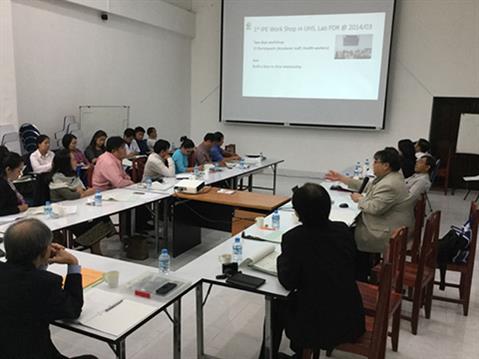
Discussion with the Inter-professional Programme Committee of the University of Health Sciences in the Lao People's Democratic Republic in 2015.
MANILA - Although many educational institutions are highly interested in accessing initiatives on transformative scale up of health professional education, it is hard for individual institution to build strategic partnership within their academic network alone. The present collaboration for development of inter-professional education (IPE) programme between Gunma University, WHO Collaborating Centre for Research and Training on Inter-professional Education and the University of Health Sciences (UHS) in the Lao People's Democratic Republic was carried out successfully under the coordination of WHO.
The programme addresses the need to substantially increase the quality and quantity of health workforce training in developing countries to achieve the health-related Sustainable Development Goals and ensure healthy lives and promote well-being for all. To improve health professional education in the Lao People's Democratic Republic, the WHO Collaborating Centre started joint activities with the Education Development Center of UHS.
The purpose of these activities was to embed the IPE programme into the community-based education programme. To implement the activities, a four-phase action plan was developed in 2014. The first three phases have been completed.
Phase 1 (Sharing the key concepts of IPE): The WHO Collaborating Centre together with WHO organized a two-day workshop at UHS. The workshop included information about the IPE core competencies, the global and regional roles of IPE and an overview of different IPE models.
Phase 2 (Programme design): Staff from the WHO Collaborating Centre and the UHS developed a tailored approach to implementing IPE using a checklist. The checklist consisted of three sections: identifying the university situation and possible IPE approaches; information on developing a programme committee organization chart; and the role of the IPE steering group.
Phase 3 (Organizing the inter-professional programme committee): Approximately 30 committee members were recruited to the committee from faculties of Medicine, Pharmacy, Dentistry, Nursing and Medical Technology. They are in charge of programme management, supervision of teachers and student evaluation. The committee decided to embed the IPE initiative into the current community-based program, and developed the following mission, values, principles and objectives of the programme from an IPE perspective. These were included in the student programme manual. The experience of planning process of the IPE programme was published in the Journal of Inter-professional Care.
Phase 4 (Implementing and Evaluating the programme): UHS started the IPE-integrated community-based programme in January 2016. The effect of the programme in changing student attitudes towards inter-professional health-care teams is being assessed using a pre- and post-design.
In response to the success of the collaboration, Dr Hideomi Watanabe, Director of the Collaborating Centre, commented “We have learnt the importance of a strategic instead of sporadic approach to disseminate IPE in Asia.” The results have been a strong reflection of the collaboration between the WHO Collaborating Centre and UHS in introducing transformative changes in health professional education.
Learn more:
Bumsuk Lee, Hiromitsu Shinozaki, Ketsomsouk Bouphavanh, Yoshiharu Tokita, Takatoshi Makino, Hiroki Matsui, Takayuki Saitoh, Fusae Tozato, and Hideomi Watanabe, A plan for embedding an inter-professional education initiative into an existing programme in a Southeast Asian university, Journal Of Inter-professional Care Vol. 30, Iss. 3, 2016 http://dx.doi.org/10.3109/13561820.2016.1149156




